| Timothy Brookes wrote this article for the 1994 Pottery Festival Souvenir Program |
For several days in late October, 1934, East Liverpool and the surrounding area became the topic of front-page stories in every paper in the nation as one of the Depression's most famous desperadoes was gunned down by local lawmen and federal agents. One Cleveland reporter, moved to write a tongue-in-cheek poem about the exciting occurrences, would tell the tale:
"Of how Pretty Boy Floyd was a doggone fool
when he went to buy a dinner near East Liverpool."
Long before his demise in Columbiana County, Charles Arthur Floyd rose through the criminal world, in the process killing at least ten people and robbing numerous banks. His notoriety was such that when John Dillinger fell outside the Biograph Theater in Chicago, J. Edgar Hoover named Floyd the second Public Enemy No. 1. Much of the interest in Floyd was due to a bloody rescue attempt in Kansas City in June 1933 which had resulted in the machine gun deaths of five persons, four of them police officers. Floyd, usually not shy about his exploits, denied any involvement but without success.
Floyd went into hiding after the so-called Union Station Massacre. However, by October of the following year, he and his companion, a thug named Adam Richetti, and two sisters whose inconvenient husbands had been eliminated by Floyd, decided to leave their hideout in Buffalo, New York, and return to Floyd's home and favorite hide-out, the Cookson Hills of Oklahoma.
On Saturday, October 20, the citizens of Wellsville, Ohio, were expecting nothing out of the ordinary. Reports of a bank robbery the previous day in Tiltonsville, forty miles down the Ohio River, were hardly grounds for concern. The dullness of the day began to change when Wellsville Police Chief John Fultz received a phone call from a resident near Silver Switch. The caller, Lon Israel, reported that he had observed two suspicious-looking men with guns hiding on a hillside. Fultz, with Special Officers Grover Potts and William Erwin, immediately went out to investigate. Discovering two men wrapped in blankets as if they were camping, Fultz approached the nearer of the two, who suddenly drew a pistol and opened fire. His companion fled up the hillside, shooting as he went. Grazed in the ankle by a bullet, the undaunted chief emptied his own revolver at the nearer man, who held his hands up in submission. As Fultz hustled his unknown prisoner back to the car, the two special police continued to exchange shots with the fleeing stranger. They later reported that twenty-nine bullets were fired at them before their assailant made good his escape. One of these shots struck Potts in the right shoulder ending his career as a volunteer policeman.
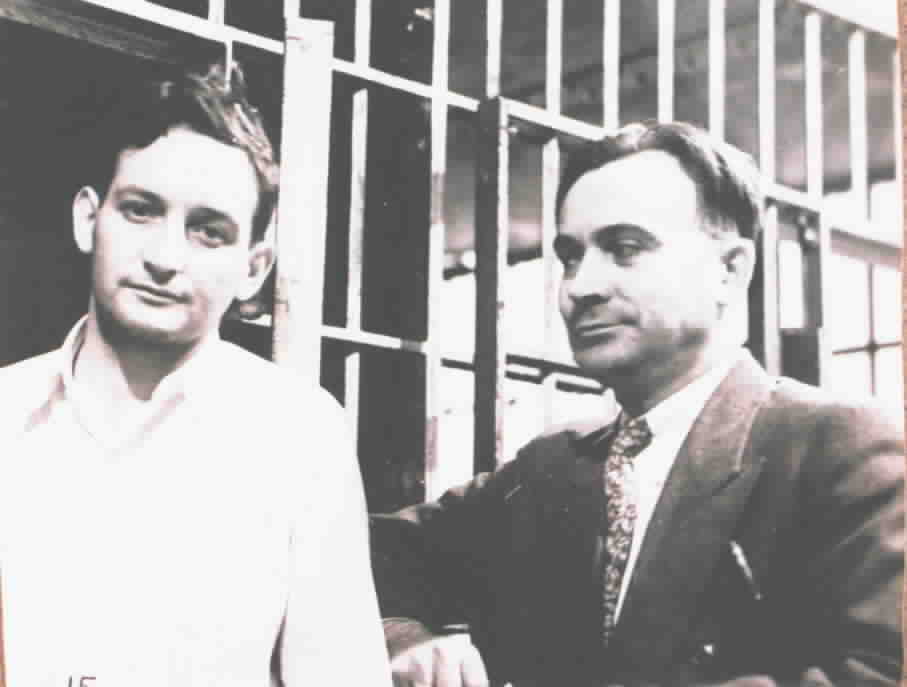 |
| Wellsville Police Chief John Fultz (right) with his prisoner, Adam Richetti. |
The prisoner gave a false name, but eventually was identified as Adam Richetti. He maintained that the escaped bandit was a Toledo man named James Warren. Fultz was unconvinced. Certain that he had traded shots with none other than Pretty Boy Floyd, he notified the federal authorities in Chicago.
While police in Wellsville speculated as to his identity, Floyd had flagged down a motorist, George McMullin of East Liverpool and put additional distance between himself and the scene of the shooting. When McMullin's Model T inopportunely ran out of gas, Floyd, with his first unnerved chauffeur in tow, commandeered a second ride from James Baum, a sixty-year-old Wellsville florist. Baum was directed to stay on back roads, but eventually his Nash was seen approaching the village of Lisbon on U.S. Route 30. Chief Fultz had warned the sheriffs department to set up a roadblock, and Floyd saw that his escape was frustrated. Deputy George E. Hayes and Lisbon Police Officer George Patterson were manning the roadblock when Floyd ordered Baum to turn back the way they had come. Although they had been told to look out for a Ford, the strange behavior of the men in the Nash seemed to demand further explanation. Hayes and Patterson followed.
The suspicious auto, after climbing the hill out of Lisbon, veered onto a secondary highway, appropriately named Roller Coaster Road. One of the many inconsistencies in the Floyd saga now occurs. According to Deputy Hayes, who was later county sheriff and lived into his eighties, Floyd broke out the rear window of the Nash and opened fire on the pursuing vehicle; one bullet smashed its windshield, narrowly missing Hayes. In this version, the officers fired at Floyd as he fled into an adjacent woods, and they continued to be raked by Floyd's return fire, even after he had gained the relative security of the trees. Somewhere "in the excitement", Hayes reported, Baum was shot in the leg.
Quite a different story was remembered by Baum's daughter. Her account agrees in large part with the Hayes version up to the beginning of the shooting. Baum told his family that when they had stopped the car, the unknown passenger had gotten into the woods without anyone shooting at him. Then, when Baum and McMullin exited the car with raised hands, the two officers opened fire on them, putting one bullet through the florist's leg and five into the car. Adding insult, the unwounded McMullin was taken back to Lisbon in handcuffs, while a bleeding Baum was told to stay put until they returned for him. Perhaps it was some consolation to be subsequently visited by the famed Melvin Purvis, who advised the family not to tell their story to the numerous reporters, as Floyd might have friends who would seek revenge.
By the end of day, most of Columbiana County was being combed by police, deputies and armed citizens. Numerous federal agents were en route, including Purvis, who took charge of the manhunt when he arrived on Sunday evening. Purvis, no doubt unknowingly, heated up a long- standing intercity rivalry by first consulting with Chief Fultz but then setting up his main headquarters in East Liverpool. Chief Fultz would later complain bitterly of Purvis's highhandedness and lack of diplomacy with his department. When Fultz's chance for retaliation came, it was fully exercised.
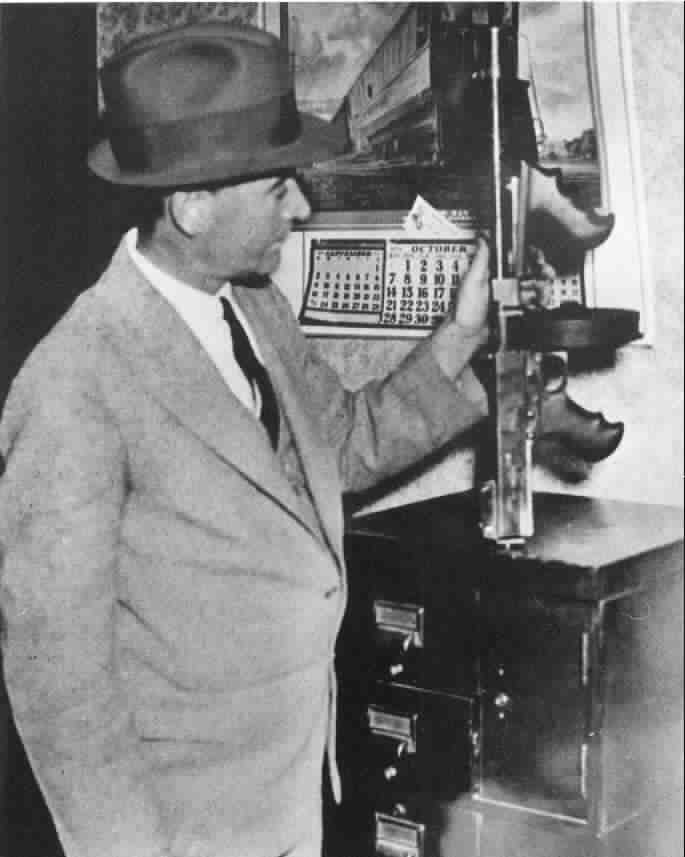 |
| The Thompson sub-machine gun recovered at the Silver Switch shootout |
On Sunday the search continued. A submachine gun was found in the vicinity of the initial confrontation, but otherwise the quarry eluded the dozens of searchers. In the Wellsville City Jail, Adam Richetti was literally surrounded by hastily deputized and heavily armed citizens who were expected to fend off any attempt by Floyd to break him out. Fingerprints provided undeniable proof of the prisoner's identity, but he remained uncooperative concerning the identity of his companion or how they had arrived in Wellsville. Fultz maintained that he had wounded Floyd, and newspaper accounts of blood found in the commandeered vehicles led police to believe that Pretty Boy was seriously wounded. Like many other parts of the story, the wounds proved to be imaginary.
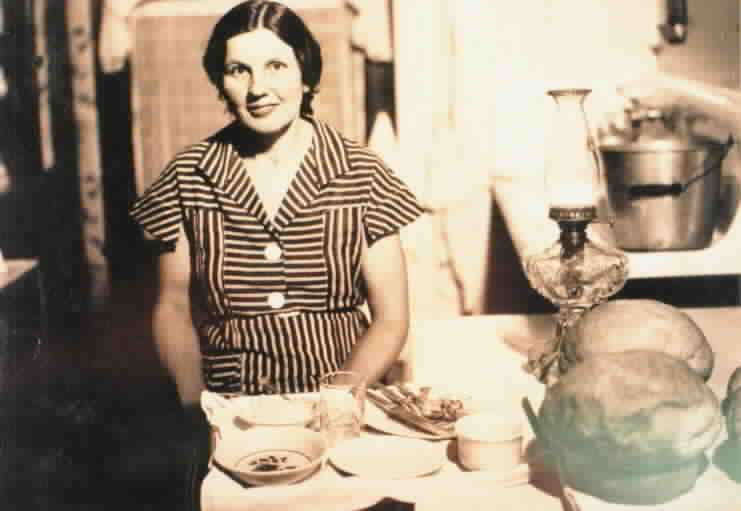 |
| Widow Ellen Conkle, with the dishes used by Floyd in what turned out to be his last meal. |
For nearly forty-eight hours, Floyd remained at large and unseen. In mid-afternoon on Monday, October 22, he emerged from the woods near an area known as Sprucevale, eight miles southeast of his last sighting, where he approached the farmhouse of Mrs. Ellen Conkle, a widow. A disheveled Floyd explained to her that he had gotten lost while hunting and had spent the previous night wandering through the woods. He was hungry, and Mrs. Conkle prepared a meal of spareribs, potatoes, rice pudding, and pumpkin pie, which Pretty Boy consumed rapidly and termed "fit for a king". He offered Mrs. Conkle a dollar for her trouble and asked to see any recent newspapers.
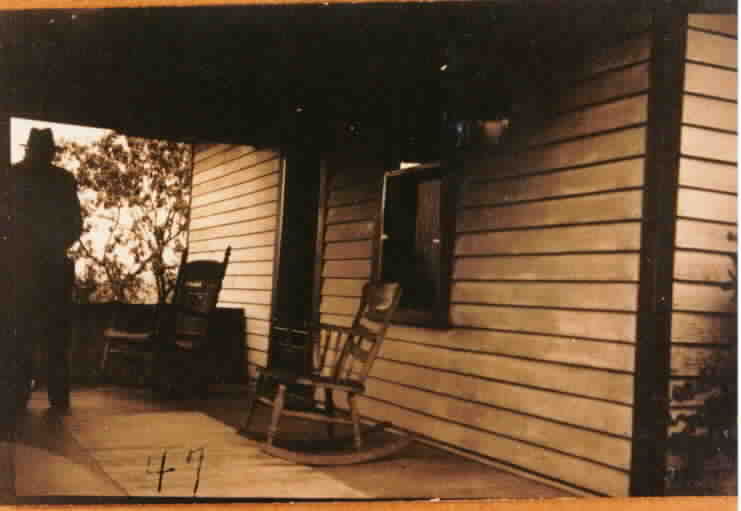 |
| Floyd read the news of Adam Richetti's capture on Mrs. Conkle's front porch |
Unknown to Floyd, he had been observed walking in the area by a farmer who telephoned township Constable Clyde Birch who, in turn, relayed the report to the East Liverpool City Police. Acting on the tip, one of several already received, East Liverpool Police Chief High J. McDermott rounded up Patrolmen Chester C. Smith, Glenn Montgomery, and Herman Roth and set out. Purvis and four agents followed in a second vehicle.
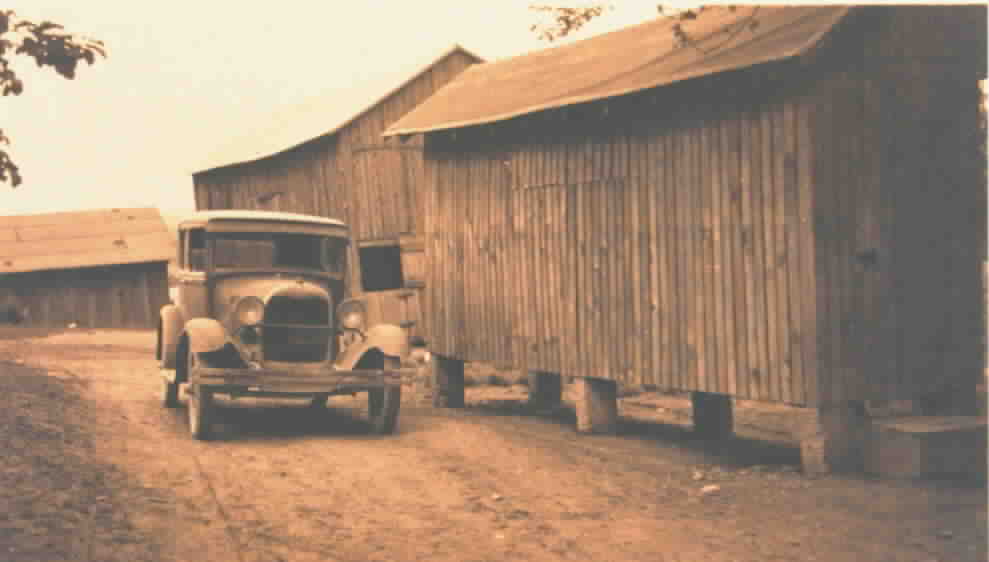 |
| Stewart Dyke's Model A-- in which Floyd took his last ride |
Meanwhile, having concluded his review of the papers, which detailed the capture of Richetti and the ongoing manhunt, Floyd asked for Mrs. Conkle's assistance in getting to Youngstown. She suggested that Floyd wait until her brother, Stewart Dyke, finished his work in the fields. Floyd sat in the front seat of Dyke's Modal A until his return. When Pretty Boy explained that he wanted transportation to Youngstown or the nearest bus line, Dyke promised to take him part of the way, and they started to pull out of the farmyard. At that crucial moment, two cars came speeding down the Sprucevale Road toward the Conkle farm. Floyd, sensing danger, ordered Dyke to pull the car behind an adjacent corncrib, saw a pair of blue-trousered legs get out of the car. As the police and federal agents approached the corncrib, Floyd made a break for the woods, holding a Colt automatic in his right hand.
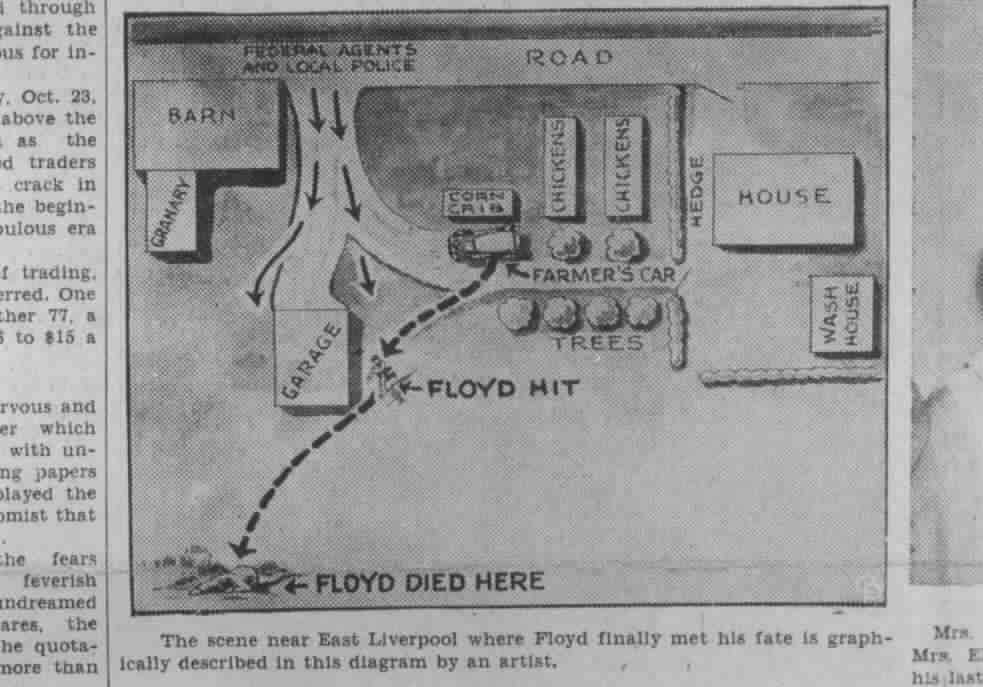 |
| The scene near East Liverpool where Floyd finally met his fate is graphically described in this diagram by an artist as published in the East Liverpool Review |
Nine officers, variously armed with pistols, rifles, and shotguns, blazed away as Floyd zigzagged across the field. Ninety-three shots were directed at the outlaw; for once, he did not shoot back. Hit, Floyd fell to his knees, then got up and continued his race for life. A second bullet knocked him down to stay.
Not surprisingly, the accounts of the participants differ widely. Purvis later claimed that Floyd was hit by an agent armed with a Tommy gun. Patrolman Chester Smith asserted that it was his shots with a .32-20 Winchester that had dropped Floyd and, further, that the federal agents were armed only with pistols and "couldn't have hit anything at that distance with their handguns".
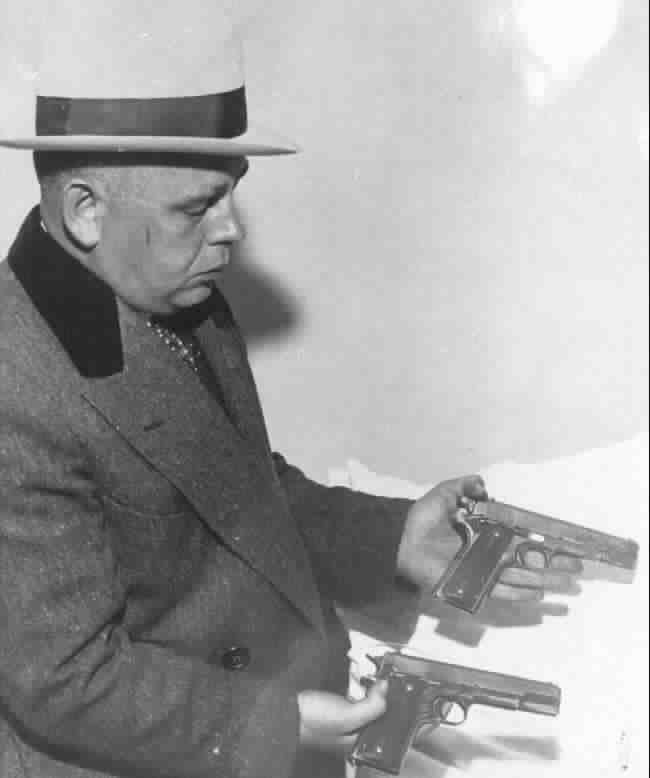 |
| The pistols taken from Floyd at his capture |
Floyd was alive when the lawmen came up to where he lay. The Colt was removed from his right hand, which had been paralyzed by a wound. A backup gun was found in the waistband of his trousers.
When Purvis asked the criminal if he was Pretty Boy Floyd, he received the curt response, "I'm Floyd". He then asked the police, "Where's Etti?", presumably a reference to his captured associate. When asked by Purvis about the Kansas City Massacre, Floyd snapped, "I won't tell you anything, you son-of-a-bitch." Depending on whose version is more accurate, these may well have been Floyd's last words. The three Liverpool patrolmen carried him to the shelter of a large apple tree where Public Enemy No. 1 died.
Purvis quickly left the scene in order to place a telephone call to J. Edgar Hoover. Floyd's body was driven back to East Liverpool, propped up in the rear seat between Officers Smith and Montgomery. They left the body at the Sturgis Funeral Home.
Within hours a telegram was received from Floyd's mother in Oklahoma, requesting that her son's body not be photographed or exhibited to the public. Her wishes were ignored as a flood of curiosity seekers lined up to view Floyd's body, which was displayed lying on a cot. Newsmen estimated that more than ten thousand people filed past the corpse that night and the following day. Numerous photos were taken, and a pottery worker was permitted to make a death mask from which a number of plaster casts were distributed among the officers prominent in running him down.
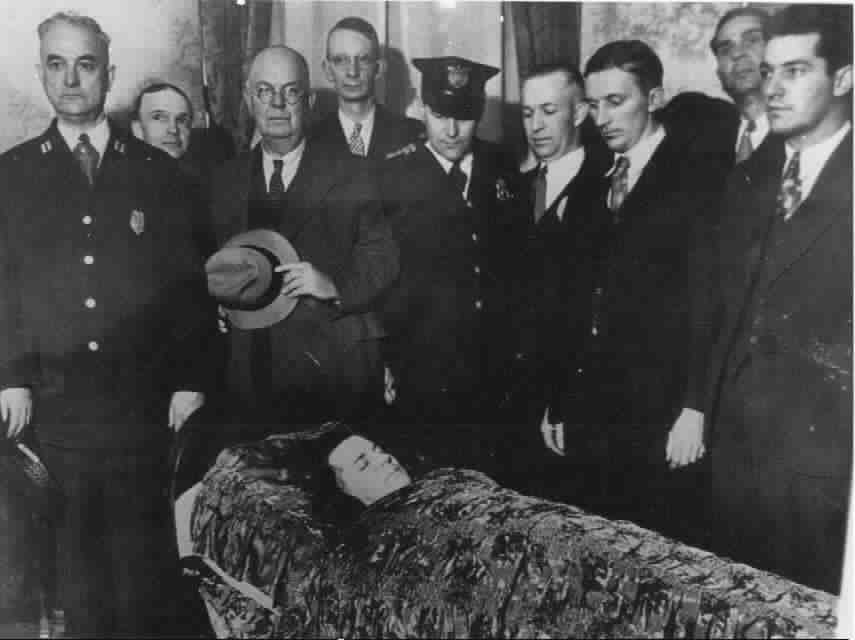 | 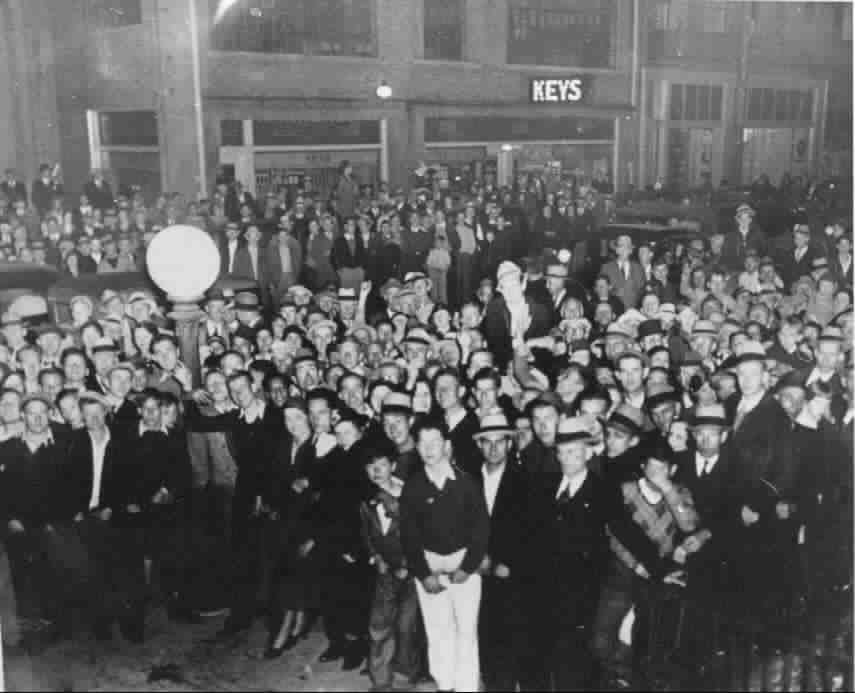 |
| The body was displayed on a cot while crowds waited hours to view the body | |
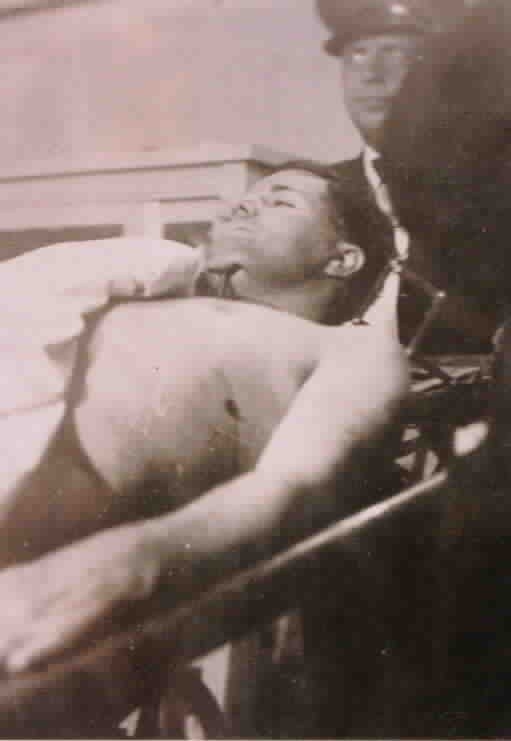 |
| Floyd's body at the Sturgis Funeral Home morgue - note bullet wound in left torso. |
An extra edition of the East Liverpool Review reported that Floyd's body contained a dozen wounds. Later, however, doctors who had examined the body closely described only two bullet wounds through the lower torso and one in the right forearm.
On the morning of October 24, Floyd's body was shipped home on a Pennsylvania Railroad baggage car. Four days later the finally peaceful outlaw's interment in Akins, Oklahoma, attracted more than fifty thousand curiosity seekers to the biggest funeral ever seen in that state.
While the shooting may have ended on the Conkle farm, the fighting between federal authorities and Chief Fultz was just warming up. Purvis returned to Wellsville and requested that Richetti he turned over to federal authorities who were anxious to interrogate him regarding the Union Station slayings. Chief Fultz's outright refusal to deal with Purvis remained firm, ever after criticism from Hoover himself. Instead, Richetti was arraigned in Wellsville Mayor's Court on charges of carrying a concealed weapon and shooting with intent to kill. The prisoner, who had $98 on him when captured, pleaded guilty to the weapons charge and was fined $75 and costs. The following day he was transferred to the antiquated county jail in Lisbon where he was twice paraded outside for the benefit of assembled schoolchildren.
| Editor's note: According to the FBI website (link below) the women were identified as Rose and Beulah Baird who showed up at Floyd's funererl in Akins, OK. |
Once he learned of Floyd's death, Richetti explained that while approaching Wellsville, their car had been damaged in an accident and needed repairs. The pair decided that it would be safer to send their female companions into town with the car while Floyd and Richetti waited in the hollow where they were discovered. The identity of the women was never disclosed, and they apparently left the area after the first gun battle.
Eventually, under threat of federal contempt citations, the Wellsville authorities permitted Richetti's return to Kansas City, where he was convicted of murder and became the first to die in Missouri's newly constructed gas chamber. The submachine gun found by Chief Fultz was later turned over to the FBI who displayed it, along with Floyd's Colt, in their Washington, D.C., headquarters.
The Pretty Boy Floyd story still retains a curious attraction in the area where he met his demise. Any discussion of the outlaw brings out the opinions of those who "knew somebody" or "saw something" and thus are privy to the "real story". People of sufficient years frequently boast of having stood in line for a brief view of Floyd laid out in death.
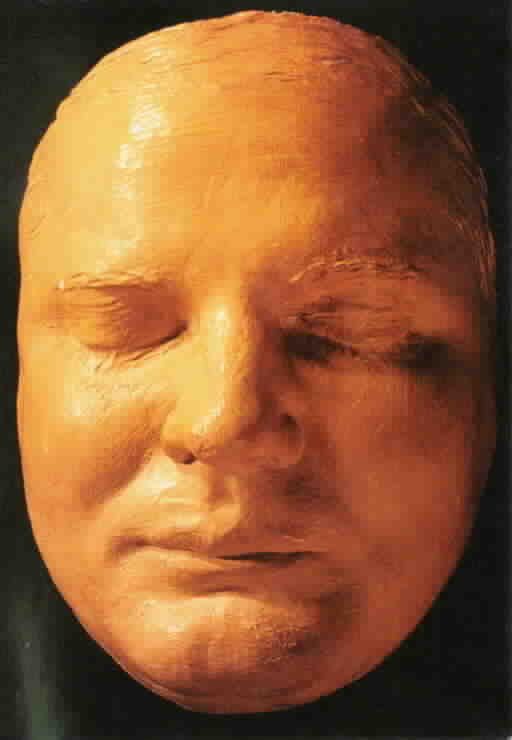 |
| Plaster death mask made while Floyd was being prepared for public display. |
In his final years, Chester C. Smith, the former East Liverpool patrolman and last survivor of the law enforcement officers present at the Conkle farm, announced for the first time that after Floyd's wounding, Melvin Purvis had ordered one of the agents to finish him off. In 1979, Time magazine carried a brief article incorporating Smith's expose, including the assertion that Floyd was summarily executed with a burst from a submachine gun. While contradicting his earlier accounts, Smith's allegations gave new life to an old story and its many variations. Smith's death in 1984 marked the end of the direct participants in the Floyd story, but certainly not the end of the controversy it engendered.
Poor Charles Floyd was the bandits' pride -
They knew him in the hills where he did hide -
But Columbiana County ain't no Ozark Hill
And down in Ohio they shoot to kill
ADDITIONAL iNFORMATION
A photo Gallery of Pretty Boy Floyd:
http://www.angelfire.com/folk/longtimecoming/prettyboy/pictures.html
Coroner's Report - Pretty Boy Floyd
Autopsy of Charles "Pretty Boy" Floyd
As mentioned above, there are numerous versions of the Pretty Boy Floyd story. The following links show some of the differences:
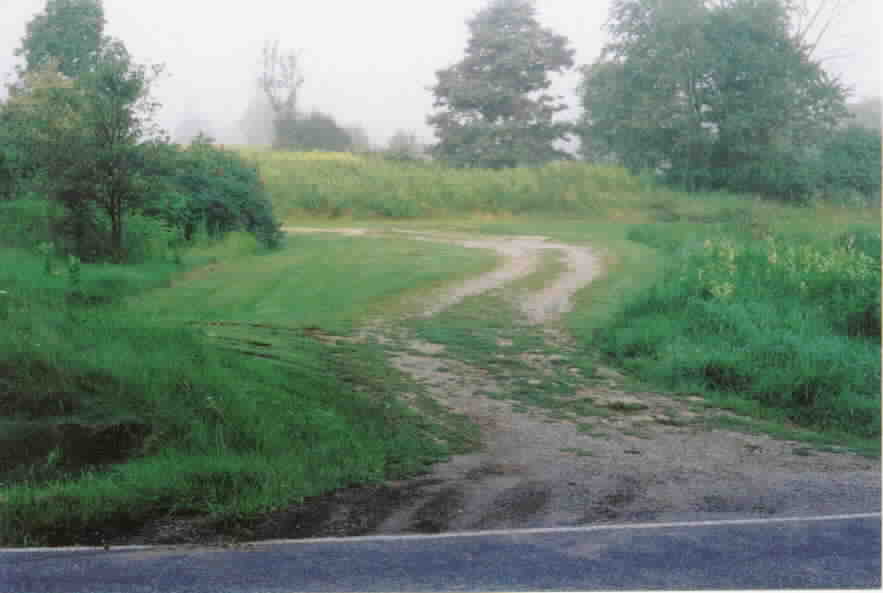 | 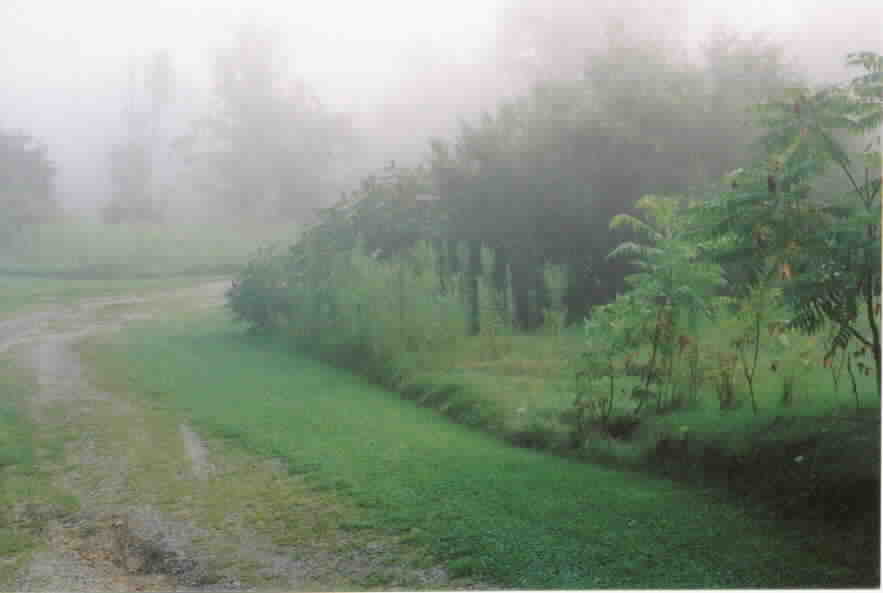 |
| Two views of the Conkle Farm site: on the left the entrance to the farm, on the right the site of the old corn crib. | |
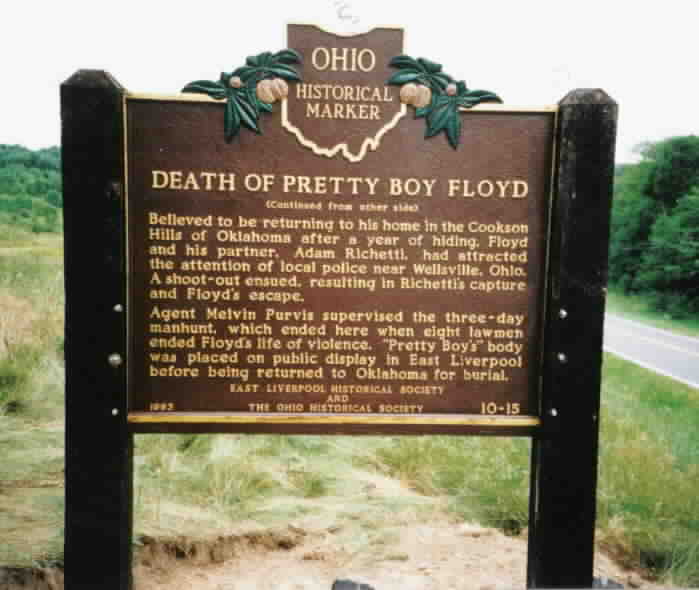 | 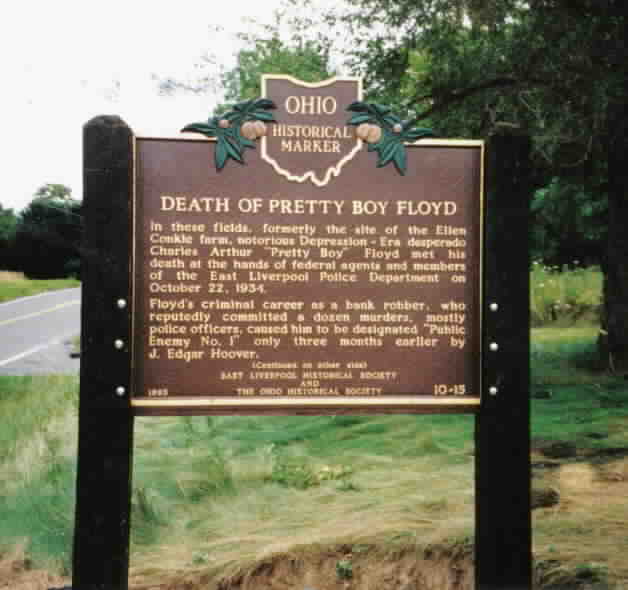 |
| In 1993, the East Liverpool Historical Society and the Ohio Historical Society teamed up to place a marker at the site of the Conkle farm | |
This site is the property of the East Liverpool Historical Society.
Regular linking, i.e. providing the URL of the East Liverpool Historical Society web site for viewers to click on and be taken to the East Liverpool Historical Society entry portal or to any specific article on the website is legally permitted.
Hyperlinking, or as it is also called framing, without permission is not permitted.
Legally speaking framing is still in a murky area of the law though there have been court cases in which framing has been seen as violation of copyright law. Many cases that were taken to court ended up settling out-of-court with the one doing the framing agreeing to cease framing and to just use a regular link to the other site.
The East Liverpool Historical Society pays fees to keep their site online. A person framing the Society site is effectively presenting the entire East Liverpool Historical Society web site as his own site and doing it at no cost to himself, i.e. stealing the site.
The East Liverpool Historical Society reserves the right to charge such an individual a fee for the use of the Society’s material.